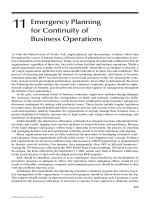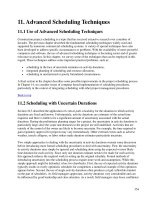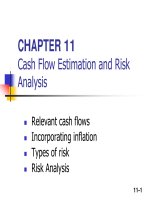Lecture Computing for management - Chapter 11
Bạn đang xem bản rút gọn của tài liệu. Xem và tải ngay bản đầy đủ của tài liệu tại đây (2.44 MB, 63 trang )
Internet and the World Wide
Web
Lecture 11
Summary of Previous
Introduction to Telecommunications
Basic Components of Communications
Telecommunications Media
Rate
of data transfer
Essential computer Network Terminologies
Network
Topology
Classification of Computer Networks
Network Devices
Recognize the individual components of the big
picture of computer networks
Summary of Previous
Computer Network Layouts
Microcomputer-to-local area network
Microcomputer-to-Internet
Local area network-to-local area network
Personal area network-to-workstation
Local area network-to-metropolitan area
network
Local area network-to-wide area network
Summary of Previous
Sensor-to-local
area network
Satellite and microwave
Cell phones
Computer terminal / microcomputer-tomainframe
Today’s Lecture
The Internet
History
Resource
that can be shared
Applications of Internet
Client/Server Architecture
Internet Service Providers
HTML
Web Browsers
Today’s Lecture
Searching the Web
Tips
and Techniques
Search Process
Different Web search tools
Outlook Express
Summary
The Internet
What is the Internet?
A global network of networks
It is based on Internet Protocol (IP)
A
standard (Language) used over internet for
computers to communicate with each other.
Who can Join Internet?
Anyone with a computer and internet connection.
At
home, office, public places etc.
Any network can join the Internet
Includes research, academic, community &
commercial networks
Pakistan have seen tremendous growth of internet in
past few years.
Internet at different places
Popularity of Internet
Impact of Internet on Society
The Internet
Connects over a hundred thousand
networks from nearly 200 countries.
According to Internet World Statistics,
internet users are 32.7% of total world
population, with the annual growth of
528.1%. (2011 Report)
Internet Growth Rate in Pakistan
Up till 2010 16.78% of Pakistan Population was using
Internet
Where did internet come from?
Late 1960s, ARPA (Advanced Research
Projects Agency). Supported by
Department of Defense, USA. To share
information within one university.
ARPANET. To connect USA universities
and organizations to share info and
communicate. TCP Protocol.
1973 – ARPANET connects to Europe
The ARPANET Team
Brief History
Mid-1980s – NSFNet (National Science
Foundation Network, USA)
Formed
network between supercomputers
Internet of NSFNet was the link to ARPANET
No commercial traffic allowed
1990s
ARPANET
shut down
NSFNet abandoned
Commercial networks take over
What’s so special about the
Internet?
Developed for information and project
sharing (academic purposes).
Original intention
to
allow different machines to understand
each other.
Excellent for broadcasting data and
connecting computers: less reliable for
security.
What can be shared over internet?
Many subjects and formats available to
share
Documents
Graphics, video & audio
Software (free & shareware)
Newspapers
Directories
Library catalogues & databases
Books & journals
Junk
HEC Pakistan Online Digital Library
Pakistani Internet Daily Newspaper
Internet Applications
Electronic Mail (email)
A
method of exchanging digital messages
from an author to one or more recipients.
Some early email systems required that the author
and the recipient both be online at the same time,
in common with instant messaging.
Modern email operates across the Internet or other
computer networks.
Domain
mail server collects incoming mail
and transmits outing mail
Internet Applications
File Transfer Protocol (FTP)
It is a standard protocol used to exchange and
manipulate files over internet
Its purpose is to remotely share files and software
Internet Applications
Voice Over IP (VoIP)
VoIP (voice over IP) is an IP telephony term for a set
of facilities used to manage the delivery of voice
information over the Internet.
Internet Applications
Telnet
A program that runs over your PC and
connects it to a server on the network.
You can enter commands using Telnet
program and they will be executed as if you
were directly entering them on the server
command prompt.
This allows you to control the server and
communicate with other servers on the
network.
Telnet Example









